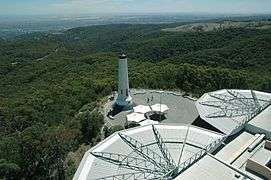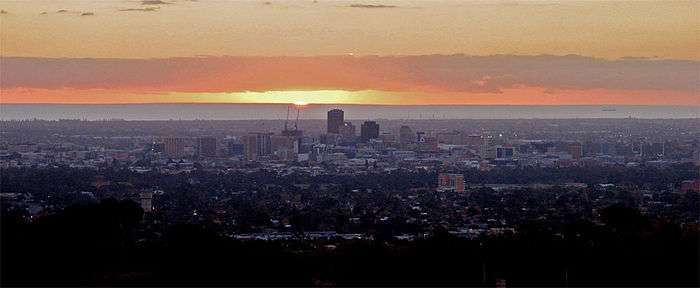Mount Lofty
| Mount Lofty | |
|---|---|
 Mount Lofty | |
| Highest point | |
| Elevation | 727 m (2,385 ft) |
| Coordinates | 34°58′S 138°42′E / 34.967°S 138.700°ECoordinates: 34°58′S 138°42′E / 34.967°S 138.700°E |
| Geography | |
| Location | Cleland, South Australia, Australia[1] |
| Parent range | Mount Lofty Ranges |
| Climbing | |
| First ascent |
April 1831 Collet Barker |


Mount Lofty (34°58′S 138°42′E / 34.967°S 138.700°E, elevation 727 metres AHD) is the highest point in the southern Mount Lofty Ranges. It is located about 15 km east of the Adelaide city centre in South Australia, and has panoramic views of the city and the Adelaide plains to the west, and of the Picadilly Valley to the east.
The summit can be accessed by road from the South Eastern Freeway at Crafers, and from the eastern suburbs via Greenhill Road and the Mount Lofty Scenic Route. The more enthusiastic can walk up the gully from Waterfall Gully, through the Cleland Conservation Park and from Chambers Gully. The track from Waterfall Gully to the summit is a 4 km uphill trek and one of Adelaide's most popular exercise circuits so the park at the bottom is often busy. The summit provides panoramic views across Adelaide, and a cafe-restaurant and gift shop. These are relatively new due to protracted disputes over appropriate development following the destruction of the old cafe in the 1983 Ash Wednesday fires.
On the ridge near the summit are three television transmission towers (the northernmost being that of the ABC), and the Mount Lofty Fire Tower operated by the Country Fire Service.
The summit has become a popular spot for tourists to Adelaide, and also for cyclists coming up the old Mount Barker Road through Eagle on the Hill; this former section of National Highway No.1 has been superseded by the Heysen Tunnels.
History
European discovery and use
Mount Lofty was named by Matthew Flinders on 23 March 1802 during his circumnavigation of the Australian continent.[2] It was first climbed by a European when the explorer Collet Barker climbed it in April 1831, almost six years before Adelaide was settled.
A stone cairn at the summit was originally used to mark the trig point, and in 1885 this was replaced by an obelisk which served as the central reference point for surveying purposes across Adelaide. In 1902 the obelisk was rededicated and renamed as the "Flinders Column".[3]
The Summit was closed to the public during the Second World War, when the obelisk was considered an indispensable navigation aid. A flashing strobe was fitted to the top to improve visibility at night. This strobe was removed after the war, but then re-installed in the 1990s, when the obelisk was repainted and restored during construction of the new kiosk.
Historic houses
Summit Road, Mt Lofty, was previously one of the most well-known addresses in South Australia, with the summer houses of several prominent families being located there. These were all destroyed or severely damaged by the Ash Wednesday bushfires in 1983, but have subsequently been restored.[4] They include:
- Mt Lofty House (1858) - Arthur Hardy[5]
- Eurilla (1884) - William Milne, 1917 Lavington Bonython, 1972 Kym Bonython, 1998[6]
- Carminow (1885) - Thomas Elder,[7] 1905 Langdon Bonython[8]
Other buildings, such as "St. Michael's Monastery" (an Anglican Church retreat) and "Arthur's Seat", for a time known as Stawell School, a private school for girls, were never rebuilt.[9] Part of this property was excised for the ABC-TV transmitter building and mast.
Snow
Due to Adelaide's mild winters, temperatures cold enough to produce snow in the Adelaide metropolitan area never occur, and the nearest snowfields to Adelaide are in eastern Victoria, over 700 km away. However, light snowfalls (rarely lasting for more than a day) are not uncommon on the summit (although it is possible for Mount Lofty to go two or three years without any snowfall.) This is a huge novelty for the approximately 1 million residents of the Adelaide Plains, (particularly for the children), and a photograph of the event has made the front page of the local newspaper multiple times in the past.[10] Mount Lofty is the coldest location in the Adelaide area; during winter months the temperature may not exceed 3-4 °C on some days. The summit is the most common location for snow in South Australia; rare snowfalls sometimes occur in other parts of the Mount Lofty Ranges, and in Northern South Australia.
See also
References
- 1 2 "Search result for "Mount Lofty (Mountain)" (Record no. SA0041096) with the following layers selected - "Suburbs and Localities" and " Place names (gazetteer)"". Property Location Browser. Government of South Australia. Retrieved 19 July 2016.
- ↑ Flinders, Matthew (1966) [1814]. A Voyage to Terra Australis : undertaken for the purpose of completing the discovery of that vast country, and prosecuted in the years 1801, 1802, and 1803 in His Majesty's ship the Investigator, and subsequently in the armed vessel Porpoise and Cumberland Schooner; with an account of the shipwreck of the Porpoise, arrival of the Cumberland at Mauritius, and imprisonment of the commander during six years and a half in that island. (Facsimile ed.). Adelaide; Facsimile reprint of: London : G. and W. Nicol, 1814 ed. In two volumes, with an Atlas (3 volumes): Libraries Board of South Australia. p. 251. Retrieved 4 January 2014.
- ↑ Smith, Pam; Pate, F. Donald; Martin, Robert (2006). Valleys of Stone: The Archaeology and History of Adelaide's Hills Face. Belair, South Australia: Kōpi Books. p. 232. ISBN 0 975 7359-6-9.
- ↑ Wall, Barbara (2008). "Mount Lofty Summit Road: A survey 1841-2008 (research paper)".
- ↑ "Explore Mt Lofty House". Mt Lofty House - Adelaide Hills - Grand Mercure. Retrieved 6 May 2013. History
- ↑ Amanda Ward (February 2008). "Eurilla rises again". SA Life Magazine, vol. 5, no. 2. pp. 32–43. Retrieved 17 June 2012.
Keelan, Michael (February 2008). "Eurilla : for the love of trees". SA Life Magazine, vol. 5, no. 2. pp. 44–51. Retrieved 17 June 2012.
Photos: 1890,1890,1905,1983. See also: ,, - ↑ Fayette Gosse. "Elder, Sir Thomas (1818–1897)". Australian Dictionary of Biography, National Centre of Biography, Australian National University. Retrieved 6 May 2013.
- ↑ A Trip to Mount Lofty, 31 March 1906, The Advertiser pg.6
- ↑ Barbara Wall A Short History of Stawell School: The forgotten school on Mount Lofty published for Mount Lofty Districts Historical Society by Peacock Publications 2012 ISBN 978--1-921601-69-9
- ↑ Advertiser coverage of "Snow at Mt Lofty": 1 August 2014; 22 July 2013; 11 October 2012.
External links

